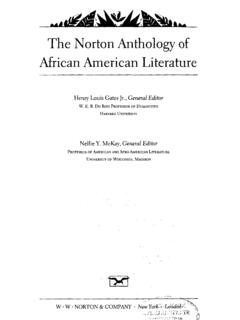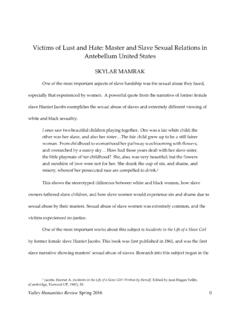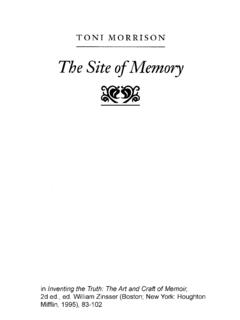Transcription of DUKE UNIVERSITY LIBRARY - Free Book's Mania
1 DUKE UNIVERSITY LIBRARY Gl^t o Isabelle & Louis Budd Digitized by the Internet Archive in 2017 with funding from Duke UNIVERSITY Libraries KINDRED Other Volumes in the Black Women Writers Series Series Editor: Deborah E. McDowell Marita Bonner/Frye Street and Environs Octavia E. Butler/Kindred Alice Childress/Lzfce One of the Family Frances E. W. Harper//o/a Leroy Gayl lones/Corregidora; Eva s Man Ann Petry/The Narrows; The Street Carlene Hatcher Polite/77ze Flagellants KINDRED Octavia E. Butler With an Introduction by Robert Crossley Beacon Press Boston Beacon Press 25 Beacon Street Boston, Massachusetts 02108 Beacon Press books are published under the auspices of the Unitarian Universalist Association of Congregations.
2 1979 by Octavia E. Butler Introduction 1988 by Beacon Press First published as a Beacon paperback in 1988 All rights reserved Printed in the United States of America 95 94 93 92 91 90 89 88 8 7 6 5 4 3 2 1 LIBRARY of Congress Cataloging-in-Publication Data Butler, Octavia E. Kindred. (Black women writers series) I. Title. II. Series. 1988 813'.54 87-47879 ISBN 0-8070-8305-4 To Victoria Rose, friend and goad Contents INTRODUCTION BY ROBERT CROSSLEY ix PROLOGUE 9 THE RIVER 12 THE FIRE 18 THE FALL 52 THE FIGHT 108 THE STORM 189 THE ROPE 240 EPILOGUE 262 Introduction Robert Crossley What tangled skeins are the genealogies of slavery!
3 Harriet Jacobs, Incidents in the life of a slave girl , 1861 I The American slave narrative is a literary form whose historical bound aries are firmly marked. While first-person narratives about oppression and exclusion will persist as long as racism persists, slave narratives ceased to be written when the last American citizen who had lived under institutionalized slavery died. The only way in which a new slave -memoir could be written is if someone were able to travel into the past, become a slave , and return to tell the story. Because the laws of physics, such as we know them, preclude traveling backwards in time, such a book would have to be a hybrid of autobiographical narrative and scientific fantasy.
4 That is exactly the sort of book Octavia Butler imagined when she wrote Kindred, first published in 1979. Like all good works of fiction, it lies like the truth. Kindred begins and ends in mystery. On June 9, 1976, her twenty- sixth birthday, Edana, a black woman moving with her white husband Kevin Franklin to a new house in a Los Angeles suburb, is overcome by nausea while unpacking cartons. Abruptly she finds herself kneeling on a riverbank; hearing a child s screams, she runs into the river to save him, applies artificial respiration, and as the boy begins breathing again she looks up into a rifle barrel.
5 Again she sickens and is once more in her new house, but now she is soaked and covered in mud. This is the first of several such episodes of varying duration which make up the bulk of the novel. Sometimes Dana (the shortened form of her name she X INTRODUCTION prefers) is transported alone, sometimes with Kevin; but the dizzy spells that immediately precede her movements occur without warning and she can induce her return to Los Angeles only at the hazard of her life . To her horror Dana discovers during a second and longer episode of dis orientation that she is moving not simply through space but through time as well to antebellum Maryland, to the plantation of a slaveowner who is her own distant (though not nearly distant enough) ancestor.
6 These trips, like convulsive memories dislocating her in time, occupy only a few minutes or hours of her life in 1976, but her stay in the alternative time is stretched as she lives out an imposed remembrance of things past. Because of this dual time level a brief absence from Los Angeles may result in months spent on the Maryland plantation, observing and suffering the backbreaking field work, persistent verbal abuse, whippings, and other daily cruelties of enslavement. Eventually Dana realizes that Rufus Weylin, the child she first rescues from drowning, periodically calls her from the twentieth century whenever his life is in danger.
7 As he grows older he becomes more repugnant and brutal, but she must try to keep him alive until he and a slave woman named Alice Greenwood conceive a child, to be named Hagar, who will initiate Dana s own family line. Only at Weylin s death does Dana return permanently to 1976. But she returns mutilated. The narrative comes full circle to the book s strange and disturbing opening paragraph: I lost an arm on my last trip home. My left arm. Although the novel illuminates the paradoxes of Dana s homecoming the degree to which her comfortable house in 1976 and the Weylin plantation are both inescapably home to her Butler is silent on the mechanics of time travel.
8 We know that Dana s arm is amputated in the jaws of the past, that time is revealed to be damaging as well as healing, that historical understanding of human crimes is never easy and always achieved at the price of suffering, that Dana s murderous relative, like Hamlet s, is more than kin and less than kind. The loss of her arm becomes in fact, as Ruth Salvaggio has suggested, a kind of birthmark, the emblem of Dana s disfigured heritage. 1 The sym bolic meanings Kindred yields are powerful and readily articulable. The literal truth is harder to state.
9 In The Time Machine (1895) H. G. Wells had his traveler display the shiny vehicle on which he rode into the future to verify the strange truth of his journey; in Kindred the method of transport remains a fantastic given. An irresistible psychohistorical force, not a feat of engineering, motivates Butler s plot. How Dana travels in time and how she loses her arm are problems of physics irrelevant to Butler s aims. In that respect Kindred reads less like Wellsian science INTRODUCTION xi fiction than like that classic fable of alienation, Kafka s Metamorphosis, whose protagonist simply wakes up one morning as a giant beetle, a fantastic eruption into the normal world.
10 Perhaps Butler deliberately sacrificed the neat closure that a scientific or even pseudo-scientific explanation of telekinesis and chronoportation would have given her novel. Leaving the novel s ending rough-edged and raw like Dana s wound, Butler leaves the reader uneasy and disturbed by the intersection of story and history rather than comforted by a tale that makes sense. Certainly, Butler did not need to show off a tech nological marvel of the sort Wells provided to mark his traveler s path through time; the only time machine in Kindred is present by implication: it is the vehicle that looms behind every American slave narrative, the grim death-ship of the Middle Passage from Africa to the slave markets of the New World.




